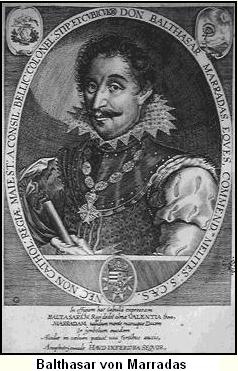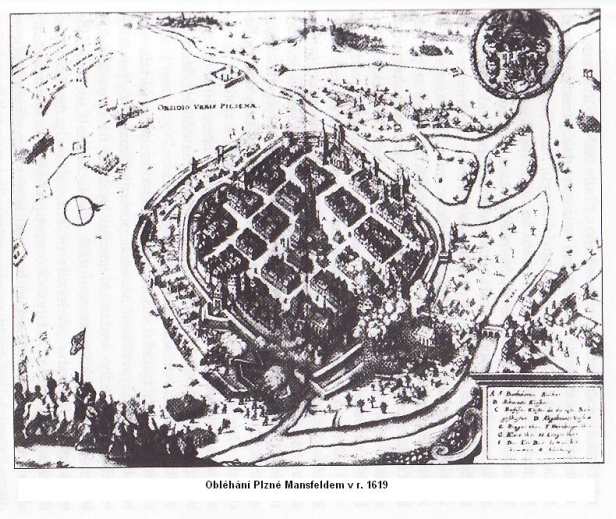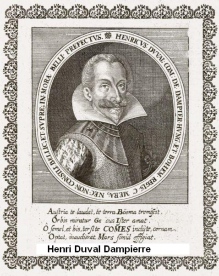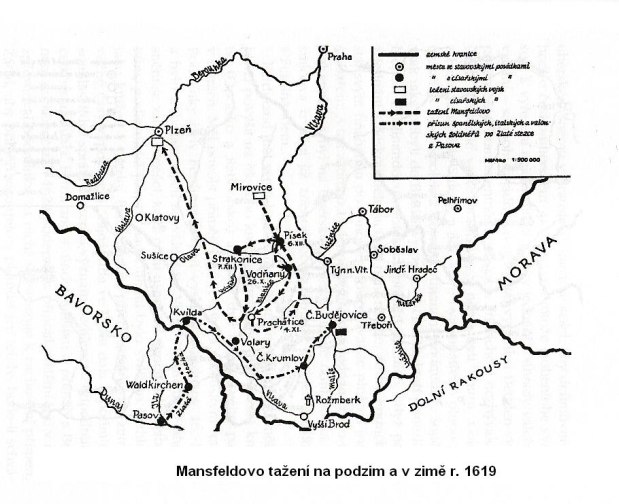The Thirty Years' War Part 3.
Categories: Years of war and revolution , Třicetiletá válka
The Battle of White Mountain Episode 3.
 Marradas succeeded in capturing Týn nad Vltavou on 22 September and set out on his march to Mansfeld, his greatest threat after he succeeded in capturing Sušice and Kašperské hory on 26 September. Mansfeld had no choice but to retreat to Pilsen. On the same day the Ligists seized Vodnany and the Imperialists Prachatice. The two armies then struck together on 29 September at Písek. The army took advantage of the inattention of the defenders and broke into the walls. The male population of Písek was inhumanly murdered and the town burned. In the following years, Písek experienced alternating periods of decline (mainly due to theThe city was successively conquered by General Buquoy, Mansfeld and, a year later, by Maximilian of Bavaria. During each conquest, the town was burned and the population almost massacred.
Marradas succeeded in capturing Týn nad Vltavou on 22 September and set out on his march to Mansfeld, his greatest threat after he succeeded in capturing Sušice and Kašperské hory on 26 September. Mansfeld had no choice but to retreat to Pilsen. On the same day the Ligists seized Vodnany and the Imperialists Prachatice. The two armies then struck together on 29 September at Písek. The army took advantage of the inattention of the defenders and broke into the walls. The male population of Písek was inhumanly murdered and the town burned. In the following years, Písek experienced alternating periods of decline (mainly due to theThe city was successively conquered by General Buquoy, Mansfeld and, a year later, by Maximilian of Bavaria. During each conquest, the town was burned and the population almost massacred.
At the same time that this massacre was taking place, Anhalt was with his army at Zwickau, but he made no attempt to help the town. With the fall of Písek, the enemy gained an important strategic point which opened the way to western and central Bohemia (in southern Bohemia only two important fortresses, Třeboň and Jindřichův Hradec, remained in Czech hands). Anhalt was in a hurry to get in the enemy's way. Already on 30 September he managed to cross the Vltava at Orlik and marched through Milovice and Březnice to Belčice on 5 October, where he was joined by King Frederick himself.
Frederick's successor was Prince Frederick Henry, who was sent to the safety of The Hague, and this caused chaos and an unfavourable impression. Confusion reigned in Prague. A war council had to meet hastily and was forced to send a special delegation to Dresden to dissuade Saxony from invading Bohemian territory. The delegation was sent at the head of Václav st. Berka of Dubá, but was not successful. The mission returned with the news that the Saxons would launch an attack on the Lužnice as soon as possible.

The Ligist-Emperor command ( Ferdinand did not grant Maximilian's request to make him commander-in-chief of both armies, so there were still two commanders, Maximiliann and Buquoy) decided that the armies would march first on Pilsen, in order to remove the dangerous stronghold of the Estates troops in their rear when attacking Prague from the west. The two armies advanced in succession at a distance of one day's march, and the Ligist army was first. On 2 October the march began from Písek through Strakonice, Horažďovice and Zelená hora. Marradas secured from Klatovy the supply of new troops marching from Bavaria through the Všerubské Pass to Domažlice. The last obstacle was on the Golden Trail, but it fell because after the conquest of Vimperk the Stavov garrison had to surrender Volary. On 8 October, the combined armies arrived in Blokovice, closely followed by Anhalt, who had already caught up with Rokycany and was trying to cover the road to Prague. Marradas captured Klatovy on 13 October. He put into battle troops coming from Bavaria ( about 8,000 men). After a stop in Blovice, the enemy's plan was already clear, and he started another march through Losiny and Štěnovice to Litice near Pilsen, where he stopped for 10 days on 10 October. The Stavov army then took up positions near Rokycany. The cross-stop was a secret meeting between Mansfeld and Buquoy.
 It was also already clear that Bethlen's diversionary attack, directed into Austria, could in no way influence the operations of the enemy armies in the Czech area, let alone stop them. Bethlen did manage to cross the Danube below Bratislava and strike at the Hainburg fortifications, but he had to fight Dampierre and suffered heavy losses. Dampierre counter-attacked the Bratislava castle (reinforcing his army by about 6,000 men). During a reconnaissance of the terrain on 9 October, Dampierre fell and the army, depressed by this loss, retreated , but even so Bethlen failed to achieve any significant success in Austria. Bethlen also undertook to send a large body of cavalry to the Bohemian battlefield to reinforce Anhalt's army. However, this help was unsuccessful, due to the development of events in Moravia.
It was also already clear that Bethlen's diversionary attack, directed into Austria, could in no way influence the operations of the enemy armies in the Czech area, let alone stop them. Bethlen did manage to cross the Danube below Bratislava and strike at the Hainburg fortifications, but he had to fight Dampierre and suffered heavy losses. Dampierre counter-attacked the Bratislava castle (reinforcing his army by about 6,000 men). During a reconnaissance of the terrain on 9 October, Dampierre fell and the army, depressed by this loss, retreated , but even so Bethlen failed to achieve any significant success in Austria. Bethlen also undertook to send a large body of cavalry to the Bohemian battlefield to reinforce Anhalt's army. However, this help was unsuccessful, due to the development of events in Moravia.
After Maximilian of Bavaria began his march to Upper Austria, the capitulating elements in Moravia around Charles Sr. of Žerotín again gained breath. A general alert was declared for the defence of the country on 7. However, the move to Bohemia, proposed by Ladislav Velen of Žerotín, was not approved because of the opposition of the Moravian nobility, among whom the agitation of Charles Sr.'s son-in-law gained momentum. Žerotín, Jiří of Náchod. His intrigues also succeeded in keeping the Hungarian auxiliary corps in Moravia for so long that it could no longer intervene in the course of events on the Bohemian battlefield. At the time of the Battle of White Mountain, he was only at Kolín.
Continued next time.........

The article is included in categories: